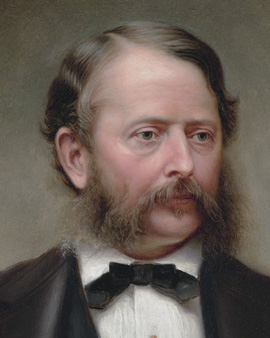John Frederick Kensett was probably born with his talent. He was born in 1816 in Chechire as the son of the steel engraver Thomas Kensett, with whom he began his training as a steel engraver and draughtsman in New Haven at a young age. In the environment of an artistic family, he was able to constantly develop his talent and expand it to such an extent that he was not only to be highly regarded in the art world, but also to join the renowned circle of founders of the Metropolitan Museum of Art in New York.
After his training in the art of steel engraving and drawing, Kensett took a job with a graphic artist, worked as a freelance steel engraver and finally devoted himself to landscape painting. From then on, landscape painting was to be the center of his artistic work. His landscape paintings are essentially influenced by the style of the Hudson River School. This group of American landscape painters, founded by Thomas Cole, was active in the middle of the 19th century and reflected in their art three areas that played a central role in American society in the 19th century The spirit of discovery, exploration and colonization of unknown worlds. The artists of this school were themselves characterized by a strong spirit of discovery and took many a dangerous and exhausting journey in their search for new and exciting motifs. Artists such as Durand and Constable, who also influenced Kensett significantly, were interested in an exact representation of individual picture details, such as plants, rocks or river courses, but were not interested in depicting a real motif in their works. Often they composed their motifs from different real elements to create an idealized landscape.
Kensett is best known for his motifs from the northern states of New York and New England, as well as the seascapes of New Jersey, New England and Long Island. While his early works can clearly be attributed to the second generation of the Hudson River School, his style developed over the course of the 1850s into a refined "luminism" with proximity to European Impressionist painting. While his pictorial compositions became simpler in the course of his creative period, in the late phase of his work he increasingly focused on the particular detail of the pictures. He liked to paint pictures of the same places over and over again, but they always differed in composition, light and atmosphere.
×





.jpg)
.jpg)
.jpg)
.jpg)
.jpg)
.jpg)
.jpg)
.jpg)
.jpg)
.jpg)
.jpg)
.jpg)
.jpg)
.jpg)
.jpg)
.jpg)
.jpg)
.jpg)
.jpg)
.jpg)
.jpg)
.jpg)
.jpg)
.jpg)
.jpg)
.jpg)
.jpg)
.jpg)
.jpg)
.jpg)
_-_(MeisterDrucke-1127942).jpg)
_-_(MeisterDrucke-1127942).jpg)
.jpg)
.jpg)
.jpg)
.jpg)
.jpg)
.jpg)
.jpg)
.jpg)
.jpg)
.jpg)
.jpg)
.jpg)
.jpg)
.jpg)
.jpg)
.jpg)
.jpg)
.jpg)
.jpg)
.jpg)
.jpg)
.jpg)
.jpg)
.jpg)
_-_(MeisterDrucke-1490279).jpg)
_-_(MeisterDrucke-1490279).jpg)
.jpg)
.jpg)
.jpg)
.jpg)
.jpg)
.jpg)
.jpg)
.jpg)
.jpg)
.jpg)
.jpg)
.jpg)
.jpg)
.jpg)
.jpg)
.jpg)
.jpg)
.jpg)
.jpg)
.jpg)
.jpg)
.jpg)
.jpg)
.jpg)
.jpg)
.jpg)
.jpg)
.jpg)
.jpg)
.jpg)
_-_(MeisterDrucke-1501998).jpg)
_-_(MeisterDrucke-1501998).jpg)
.jpg)
.jpg)
.jpg)
.jpg)
.jpg)
.jpg)
.jpg)
.jpg)
.jpg)
.jpg)
.jpg)
.jpg)
.jpg)
.jpg)
.jpg)
.jpg)
_-_(MeisterDrucke-1421879).jpg)
_-_(MeisterDrucke-1421879).jpg)
.jpg)
.jpg)
.jpg)
.jpg)
.jpg)
.jpg)
.jpg)
.jpg)
.jpg)
.jpg)
.jpg)
.jpg)
.jpg)
.jpg)
.jpg)
.jpg)
.jpg)
.jpg)
.jpg)
.jpg)
.jpg)
.jpg)
.jpg)
.jpg)
.jpg)
.jpg)
.jpg)
.jpg)
.jpg)
.jpg)
.jpg)
.jpg)
.jpg)
.jpg)
.jpg)
.jpg)
.jpg)
.jpg)
.jpg)
.jpg)
.jpg)
.jpg)
.jpg)
.jpg)
.jpg)
.jpg)
.jpg)
.jpg)
_-_(MeisterDrucke-1573559).jpg)
_-_(MeisterDrucke-1573559).jpg)
.jpg)
.jpg)
.jpg)
.jpg)
.jpg)
.jpg)
.jpg)
.jpg)
.jpg)
.jpg)
.jpg)
.jpg)
_-_(MeisterDrucke-1455246).jpg)
_-_(MeisterDrucke-1455246).jpg)
.jpg)
.jpg)
.jpg)
.jpg)
.jpg)
.jpg)
.jpg)
.jpg)
.jpg)
.jpg)
.jpg)
.jpg)
.jpg)
.jpg)
.jpg)
.jpg)
.jpg)
.jpg)
.jpg)
.jpg)
.jpg)
.jpg)






